formerly eScholarship Editions


|
|
|
|
Your search for
'South Asia' in subject
and
public
in rights
found 35 book(s). | Modify Search | Displaying 1 - 20 of 35 book(s) | |
| 1. | 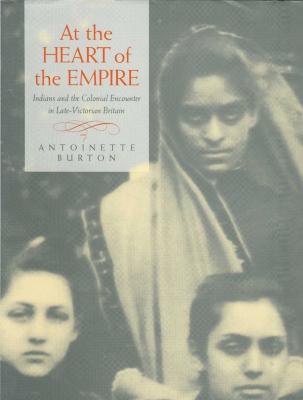 | Title: At the heart of the Empire: Indians and the colonial encounter in late-Victorian Britain Author: Burton, Antoinette M 1961- Published: University of California Press, 1998 Subjects: History | Women's Studies | Autobiographies and Biographies | South Asia | Victorian History | Travel | European History | Asian History Publisher's Description: Antoinette Burton focuses on the experiences of three Victorian travelers in Britain to illustrate how "Englishness" was made and remade in relation to imperialism. The accounts left by these three sojourners - all prominent, educated Indians - represent complex, critical ethnographies of "native" metropolitan society and offer revealing glimpses of what it was like to be a colonial subject in fin-de-siècle Britain. Burton's innovative interpretation of the travelers' testimonies shatters the myth of Britain's insularity from its own construction of empire and shows that it was instead a terrain open to continual contest and refiguration.Burton's three subjects felt the influence of imperial power keenly during even the most everyday encounters in Britain. Pandita Ramabai arrived in London in 1883 seeking a medical education and left in 1886, having resisted the Anglican Church's attempts to make her an evangelical missionary. Cornelia Sorabji went to Oxford to study law and became the first Indian woman to be called to the Bar. Behramji Malabari sought help for his Indian reform projects in England, and subjected London to colonial scrutiny in the process. Their experiences form the basis of this wide-ranging, clearly written, and imaginative investigation of diasporic movement in the colonial metropolis. [brief] Similar Items |
| 2. | 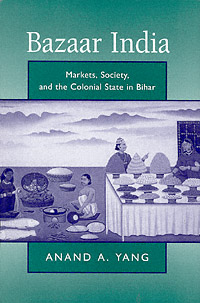 | Title: Bazaar India: markets, society, and the colonial state in Gangetic Bihar Author: Yang, Anand A Published: University of California Press, 1999 Subjects: Asian Studies | South Asia | Asian History | Economics and Business Publisher's Description: The role of markets in linking local communities to larger networks of commerce, culture, and political power is the central element in Anand A. Yang's provocative and original study. Yang uses bazaars in the northeast Indian state of Bihar during the colonial period as the site of his investigation. The bazaar provides a distinctive locale for posing fundamental questions regarding indigenous societies under colonialism and for highlighting less familiar aspects of colonial India.At one level, Yang reconstructs Bihar's marketing system, from its central place in the city of Patna down to the lowest rung of the periodic markets. But he also concentrates on the dynamics of exchanges and negotiations between different groups and on what can be learned through the "voices" of people in the bazaar: landholders, peasants, traders, and merchants. Along the way, Yang uncovers a wealth of details on the functioning of rural trade, markets, fairs, and pilgrimages in Bihar.A key contribution of Bazaar India is its many-stranded narrative history of some of South Asia's primary actors over the past two centuries. But Yang's approach is not that of a detached observer; rather, his own voice is engaged with the voices of the past and with present-day historians. By focusing on the world beyond the mud walls of the village, he widens the imaginative geography of South Asian history. Readers with an interest in markets, social history, culture, colonialism, British India, and historiographic methods will welcome his book. [brief] Similar Items |
| 3. | 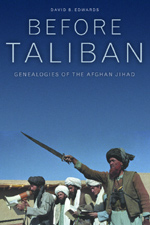 | Title: Before Taliban: genealogies of the Afghan jihad Author: Edwards, David B Published: University of California Press, 2002 Subjects: Anthropology | Cultural Anthropology | Middle Eastern Studies | Middle Eastern History | South Asia Publisher's Description: In this powerful book, David B. Edwards traces the lives of three recent Afghan leaders in Afghanistan's history--Nur Muhammad Taraki, Samiullah Safi, and Qazi Amin Waqad--to explain how the promise of progress and prosperity that animated Afghanistan in the 1960s crumbled and became the present tragedy of discord, destruction, and despair. Before Taliban builds on the foundation that Edwards laid in his previous book, Heroes of the Age, in which he examines the lives of three significant figures of the late nineteenth century--a tribal khan, a Muslim saint, and a prince who became king of the newly created state. In the mid twentieth century, Afghans believed their nation could be a model of economic and social development that would inspire the world. Instead, political conflict, foreign invasion, and civil war have left the country impoverished and politically dysfunctional. Each of the men Edwards profiles were engaged in the political struggles of the country's recent history. They hoped to see Afghanistan become a more just and democratic nation. But their visions for their country were radically different, and in the end, all three failed and were killed or exiled. Now, Afghanistan is associated with international terrorism, drug trafficking, and repression. Before Taliban tells these men's stories and provides a thorough analysis of why their dreams for a progressive nation lie in ruins while the Taliban has succeeded. In Edwards's able hands, this culturally informed biography provides a mesmerizing and revealing look into the social and cultural contexts of political change. [brief] Similar Items |
| 4. | 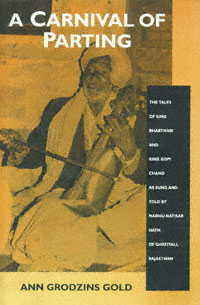 | Title: A carnival of parting: the tales of King Bharthari and King Gopi Chand as sung and told by Madhu Natisar Nath of Ghatiyali, Rajasthan Author: Nath, Madhu Natisar Published: University of California Press, 1993 Subjects: Anthropology | Cultural Anthropology | Folklore and Mythology | Hinduism | South Asia Publisher's Description: Madhu Natisar Nath is a Rajasthani farmer with no formal schooling. He is also a singer, a musician, and a storyteller. At the center of A Carnival of Parting are Madhu Nath's oral performances of two linked tales about the legendary Indian kings, Bharthari of Ujjain and Gopi Chand of Bengal. Both characters, while still in their prime, leave thrones and families to be initiated as yogis - a process rich in adventure and melodrama, one that offers unique insights into popular Hinduism's view of world renunciation. Ann Grodzins Gold presents these living oral epic traditions as flowing narratives, transmitting to Western readers the pleasures, moods, and interactive dimensions of a village bard's performance.Three introductory chapters and an interpretive afterword, together with an appendix on the bard's language by linguist David Magier, supply A Carnival of Parting with a full range of ethnographic, historical, and cultural backgrounds. Gold gives a frank and engaging portrayal of the bard Madhu Nath and her work with him.The tales are most profoundly concerned, Gold argues, with human rather than divine realities. In a compelling afterword, she highlights their thematic emphases on politics, love, and death. Madhu Nath's vital colloquial telling of Gopi Chand and Bharthari's stories depicts renunciation as inevitable and interpersonal attachments as doomed, yet celebrates human existence as a "carnival of parting." [brief] Similar Items |
| 5. | 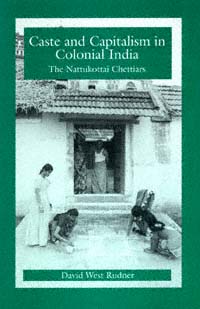 | Title: Caste and capitalism in colonial India: the Nattukottai Chettiars Author: Rudner, David West Published: University of California Press, 1994 Subjects: Anthropology | Cultural Anthropology | South Asia | Asian History Publisher's Description: David Rudner's richly detailed ethnographic and historical analysis of a South Indian merchant-banking caste provides the first comprehensive analysis of the interdependence among Indian business practice, social organization, and religion. Exploring noncapitalist economic formations and the impact of colonial rule on indigenous commercial systems, Rudner argues that caste and commerce are inextricably linked through formal and informal institutions. The practices crucial to the formation and distribution of capital are also a part of this linkage. Rudner challenges the widely held assumptions that all castes are organized either by marriage alliance or status hierarchy and that caste structures are incompatible with the "rational" conduct of business. [brief] Similar Items |
| 6. | 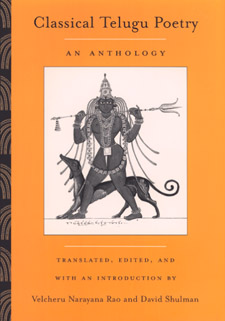 | Title: Classical Telugu poetry: an anthology Author: Nārāyaṇarāvu, Vēlcēru 1932- Published: University of California Press, 2002 Subjects: Literature | Asian Studies | Hinduism | Poetry | Folklore and Mythology | South Asia | Social Theory | Asian Literature Publisher's Description: This groundbreaking anthology opens a window on a thousand years of classical poetry in Telugu, the mellifluous language of Andhra Pradesh in southern India. The classical tradition in Telugu is one of the richest yet least explored of all South Asian literatures. This authoritative volume, the first anthology of classical Telugu poetry in English, gives an overview of one of the world's most creative poetic traditions. Velcheru Narayana Rao and David Shulman have brought together mythological, religious, and secular texts by twenty major poets who wrote between the eleventh and nineteenth centuries. The beautifully translated selections are often dramatic and unexpected in tone and effect, and sometimes highly personal. The authors have provided an informative, engaging introduction, fleshing out the history of Telugu literature, situating its poets in relation to significant literary themes and historical developments, and discussing the relationship between Telugu and the classical literature and poetry of Sanskrit. [brief] Similar Items |
| 7. | 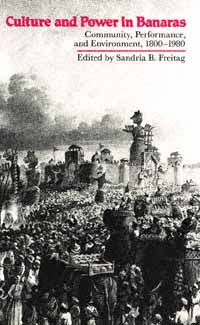 | Title: Culture and power in Banaras: community, performance, and environment, 1800-1980 Author: Freitag, Sandria B Published: University of California Press, 1989 Subjects: Asian Studies | South Asia | Asian History | Cultural Anthropology | Postcolonial Studies Publisher's Description: This collection of ten essays on Banaras, one of the largest urban centers in India's eastern Gangetic plain, is united by a common interest in examining everyday activities in order to learn about shared values and motivations, processes of identity formation, and self-conscious constructions of community. Part One examines the performance genres that have drawn audiences from throughout the city. Part Two focuses on the areas of neighborhood, leisure, and work, examining the processes by which urban residents use a sense of identity to organize their activities and bring meaning to their lives. Part Three links these experiences within Banaras to a series of "larger worlds," ranging from language movements and political protests to disease ecology and regional environmental impact. Banaras is a complex world, with differences in religion, caste, class, language, and popular culture; the diversity of these essays embraces those differences. It is a collection that will interest scholars and students of South Asia as well as anyone interested in comparative discussions of popular culture. [brief] Similar Items |
| 8. | 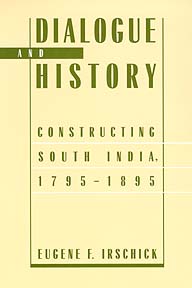 | Title: Dialogue and history: constructing South India, 1795-1895 Author: Irschick, Eugene F Published: University of California Press, 1994 Subjects: History | Asian History | South Asia | Cultural Anthropology Publisher's Description: Eugene Irschick deftly questions the conventional wisdom that knowledge about a colonial culture is unilaterally defined by its rulers. Focusing on nineteenth-century South India, he demonstrates that a society's view of its history results from a "dialogic process" involving all its constituencies.For centuries, agricultural life in South India was semi-nomadic. But when the British took dominion, they sought to stabilize the region by inventing a Tamil "golden age" of sedentary, prosperous villages. Irschick shows that this construction resulted not from overt British manipulation but from an intricate cross-pollination of both European and native ideas. He argues that the Tamil played a critical role in constructing their past and thus shaping their future. And British administrators adapted local customs to their own uses. [brief] Similar Items |
| 9. | 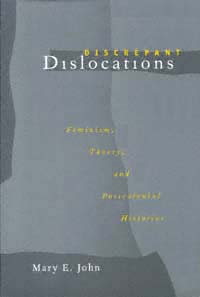 | Title: Discrepant dislocations: feminism, theory, and postcolonial histories Author: John, Mary E 1956- Published: University of California Press, 1996 Subjects: Gender Studies | Anthropology | Postcolonial Studies | South Asia | Politics Publisher's Description: Mary E. John investigates the metaphor of dislocation within and across two specific "locations" - the United States and India - in this epistemological inquiry into the production of theory in general and the grounds of feminist ethnography in particular. She probes a set of distinct but related themes: the lines of tension marking U.S. feminism, especially as foregrounded by women of color; the inescapable complexities of feminist theory and practice in India; and the traffic - in theory, feminists, and women - between the two contexts. Emphasizing the discrepancies in the dislocations articulated by feminists unequally affected by the West and its power, John explores issues of displacement and otherness in contemporary culture. She also raises compelling questions of how location impacts and is impacted by theory.As an Indian scholar schooled in the United States, John works as an "anthropologist in reverse," a "participant-observer" in the world of North American feminist theory. Her argument ranges widely, encompassing profound readings of theorists from Freud to Gayatri Spivak, Hortense Spillers to Aida Hurtado, as well as feminist theorists in India. By focusing on concepts of displacement, travel, and reterritorialization and by reaffirming a politics of location, John visualizes an alternate internationalism in our rapidly globalizing world. [brief] Similar Items |
| 10. | 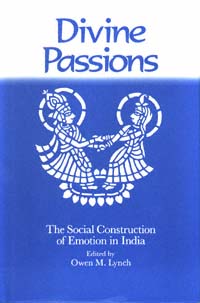 | Title: Divine passions: the social construction of emotion in India Author: Lynch, Owen M 1931- Published: University of California Press, 1990 Subjects: Anthropology | South Asia | History Publisher's Description: Naked holy men denying sexuality and feeling; elderly people basking in the warmth and security provided by devoted and attentive family members; fastidious priests concerned solely with rules of purity and minutiae of ritual practice; puritanical moralists concealing women and sexuality behind purdah's veils - these are familiar Western stereotypes of India. The essays in Divine Passions , however, paint other, more colorful and emotionally alive pictures of India: ecstatic religious devotees rolling in temple dust; gray-haired elders worrying about neglect and mistreatment by family members; priests pursuing a lusty, carefree ideal of the good life; and jokers reviling one another with bawdy, sexual insults at marriages.Drawing on rich ethnographic data from emotion-charged scenarios, these essays question Western academic theories of emotion, particularly those that reduce emotions to physiological sensations or to an individual's private feelings. Presenting an alternative view of emotions as culturally constructed and morally evaluative concepts grounded in the bodily self, the contributors to Divine Passions help dispel some of the West's persistent misconceptions of Indian emotional experience. Moreover, the edition as a whole argues for a new and different understanding of India based on field research and an understanding of the devotional (bhakti) tradition. [brief] Similar Items |
| 11. |  | Title: A flowering tree: and other oral tales from India A.K. Ramanujan ; edited with a preface by Stuart Blackburn and Alan Dundes Author: Ramanujan, A. K 1929- Published: University of California Press, 1997 Subjects: Literature | Fiction | Language and Linguistics | Asian Literature | Folklore and Mythology | South Asia Publisher's Description: This book of oral tales from the south Indian region of Kannada represents the culmination of a lifetime of research by A. K. Ramanujan, one of the most revered scholars and writers of his time. The result of over three decades' labor, this long-awaited collection makes available for the first time a wealth of folktales from a region that has not yet been adequately represented in world literature. Ramanujan's skill as a translator, his graceful writing style, and his profound love and understanding of the subject enrich the tales that he collected, translated, and interpreted.With a written literature recorded from about 800 A.D., Kannada is rich in mythology, devotional and secular poetry, and more recently novels and plays. Ramanujan, born in Mysore in 1929, had an intimate knowledge of the language. In the 1950s, when working as a college lecturer, he began collecting these tales from everyone he could - servants, aunts, schoolteachers, children, carpenters, tailors. In 1970 he began translating and interpreting the tales, a project that absorbed him for the next three decades. When Ramanujan died in 1993, the translations were complete and he had written notes for about half of the tales.With its unsentimental sympathies, its laughter, and its delightfully vivid sense of detail, the collection stands as a significant and moving monument to Ramanujan's memory as a scholar and writer. [brief] Similar Items |
| 12. | 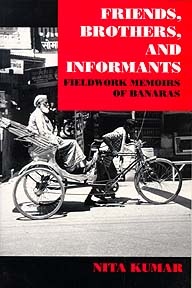 | Title: Friends, brothers, and informants: fieldwork memoirs of Banaras Author: Kumar, Nita 1951- Published: University of California Press, 1992 Subjects: Anthropology | Cultural Anthropology | South Asia Publisher's Description: "Why was Banaras such a mystery to me when I arrived in 1981? Was it ironically because I was an Indian and expected to have a privileged insight into it?"In this unusually personal, evocative account of her fieldwork experiences, Kumar tackles the dilemma of how a Western-trained Indian intellectual adapts to the field and builds deeply affecting relationships with strangers. She discloses what it is like to be a native researching her own culture, offering her fieldwork memoirs in all their spontaneity and candor.We see Banaras through her eyes when she first arrives: throngs of people, cramped and dark lodgings, unappetizing food, mischievous monkeys, and almost overwhelming filth. But as she establishes friendships, we are treated to her discoveries not only about the city and its people, but also about her place in this society.The familiar problems that face most anthropologists conducting fieldwork - of Self versus Other, objectivity versus bias, familiar circumstances versus new and dismaying ones - are given a surprising and complex dimension. Through a narration of her own experiences, the author demonstrates how personal locations - habits, preferences, expectations deriving from childhood memories, and areas of ignorance - impose themselves on the process of selection, observation, and interpretation in research. [brief] Similar Items |
| 13. | 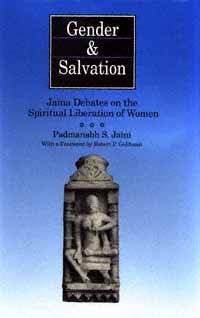 | Title: Gender and salvation: Jaina debates on the spiritual liberation of women Author: Jaini, Padmanabh S Published: University of California Press, 1991 Subjects: Religion | Buddhism | South Asia | Women's Studies Publisher's Description: Is a total renunciation of clothing a prerequisite to attaining salvation? In Gender and Salvation , P. S. Jaini brings to light heretofore untranslated texts centering on a centuries-old debate between the two principal Jaina sects, the Digambaras and the Svetambaras. At the core of the debate is the question: should gender-based differences of biology and life experience condition or limit an individual's ability to accomplish the ultimate religious goal?For the Digambaras, the example of total nudity set by Mahavira (599-527 B.C.), the central spiritual figure of Jainism, mandates an identical practice for all who aspire to the highest levels of religious attainment. For the Svetambaras, the renunciation necessary occurs purely on an internal level and is neither affected nor confirmed by the absence of clothes. Both sects agree, however, that nudity is not permitted for women under any circumstances. The Digambaras, therefore, believe that a woman cannot attain salvation, while the Svetambaras believe they can. Through their analysis of this dilemma, the Jaina thinkers whose texts are translated here demonstrate a level of insight into the material and spiritual constraints on women that transcends the particular question of salvation and relates directly to current debates on the effects of gender in our own society. [brief] Similar Items |
| 14. | 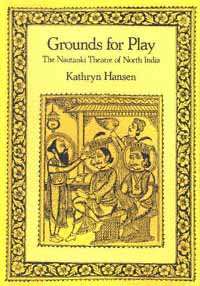 | Title: Grounds for play: the Nauṭaṅkī theatre of North India Author: Hansen, Kathryn Published: University of California Press, 1991 Subjects: Literature | Cultural Anthropology | South Asia Publisher's Description: The nautanki performances of northern India entertain their audiences with often ribald and profane stories. Rooted in the peasant society of pre-modern India, this theater vibrates with lively dancing, pulsating drumbeats, and full-throated singing. In Grounds for Play , Kathryn Hansen draws on field research to describe the different elements of nautanki performance: music, dance, poetry, popular story lines, and written texts. She traces the social history of the form and explores the play of meanings within nautanki narratives, focusing on the ways important social issues such as political authority, community identity, and gender differences are represented in these narratives.Unlike other styles of Indian theater, the nautanki does not draw on the pan-Indian religious epics such as the Ramayana or the Mahabharata for its subjects. Indeed, their storylines tend to center on the vicissitudes of stranded heroines in the throes of melodramatic romance. Whereas nautanki performers were once much in demand, live performances now are rare and nautanki increasingly reaches its audiences through electronic media - records, cassettes, films, television. In spite of this change, the theater form still functions as an effective conduit in the cultural flow that connects urban centers and the hinterland in an ongoing process of exchange. [brief] Similar Items |
| 15. | 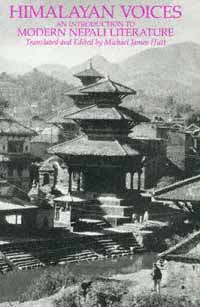 | Title: Himalayan voices: an introduction to modern Nepali literature Author: Hutt, Michael Published: University of California Press, 1991 Subjects: Literature | Literature in Translation | South Asia Publisher's Description: While the natural splendor of Nepal has been celebrated in many books, very little of the substantial body of Nepali literature has appeared in English translation. Himalayan Voices provides admirers of Nepal and lovers of literature with their first glimpse of the vibrant literary scene in Nepal today.An introduction to the two most developed genres of modern Nepali literature - poetry and the short story - this work profiles eleven of Nepal's most distinguished poets and offers translations of more than eighty poems written from 1916 to 1986. Twenty of the most interesting and best-known examples of the Nepali short story are translated into English for the first time by Michael Hutt. All provide vivid descriptions of life in twentieth-century Nepal.Although the days when Nepali poets were regularly jailed for their writings have passed, until 1990 the strictures of various laws governing public security and partisan political activity still required writers and publishers to exercise a certain caution. In spite of these conditions, poetry in Nepal remained the most vital and innovative genre, in which sentiments and opinions on contemporary social and political issues were frequently expressed.While the Nepali short story adapted its present form only during the early 1930s, it has rapidly developed a surprisingly high degree of sophistication. These stories offer insights into the workings of Nepali society: into caste, agrarian relations, social change, the status of women, and so on. Such insights are more immediate than those offered by scholarly works and are conveyed by implication and assumption rather than analysis and exposition.This book should appeal not only to admirers of Nepal, but to all readers with an interest in non-Western literatures. Himalayan Voices establishes for the first time the existence of a sophisticated literary tradition in Nepal and the eastern Himalaya. [brief] Similar Items |
| 16. | 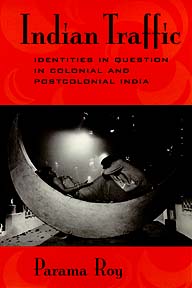 | Title: Indian traffic: identities in question in colonial and postcolonial India Author: Roy, Parama Published: University of California Press, 1998 Subjects: Postcolonial Studies | Literary Theory and Criticism | South Asia | Gender Studies Publisher's Description: The continual, unpredictable, and often violent "traffic" between identities in colonial and postcolonial India is the focus of Parama Roy's stimulating and original book. Mimicry has been commonly recognized as an important colonial model of bourgeois/elite subject formation, and Roy examines its place in the exchanges between South Asian and British, Hindu and Muslim, female and male, and subaltern and elite actors. Roy draws on a variety of sources - religious texts, novels, travelogues, colonial archival documents, and films - making her book genuinely interdisciplinary. She explores the ways in which questions of originality and impersonation function, not just for "western" or "westernized" subjects, but across a range of identities. For example, Roy considers the Englishman's fascination with "going native," an Irishwoman's assumption of Hindu feminine celibacy, Gandhi's impersonation of femininity, and a Muslim actress's emulation of a Hindu/Indian mother goddess. Familiar works by Richard Burton and Kipling are given fresh treatment, as are topics such as the "muscular Hinduism" of Swami Vivekananda. Indian Traffic demonstrates that questions of originality and impersonation are in the forefront of both the colonial and the nationalist discourses of South Asia and are central to the conceptual identity of South Asian postcolonial theory itself. [brief] Similar Items |
| 17. | 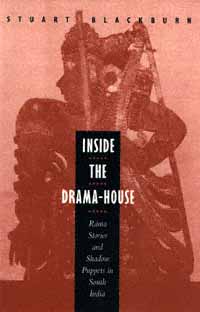 | Title: Inside the drama-house: Rama stories and shadow puppets in South India Author: Blackburn, Stuart H Published: University of California Press, 1996 Subjects: Anthropology | Asian Studies | South Asia | Cinema and Performance Arts | Hinduism Publisher's Description: Stuart Blackburn takes the reader inside a little-known form of shadow puppetry in this captivating work about performing the Tamil version of the Ramayana epic. Blackburn describes the skill and physical stamina of the puppeteers in Kerala state in South India as they perform all night for as many as ten weeks during the festival season. The fact that these performances often take place without an audience forms the starting point for Blackburn's discussion - one which explores not only this important epic tale and its performance, but also the broader theoretical issues of text, interpretation, and audience.Blackburn demonstrates how the performers adapt the narrative and add their own commentary to re-create the story from a folk perspective. At a time when the Rama story is used to mobilize political movements in India, the puppeteers' elaborate recitation and commentary presents this controversial tale from another ethical perspective, one that advocates moral reciprocity and balance.While the study of folk narrative has until now focused on tales, tellers, and tellings, this work explores the importance of audience - absent or otherwise. Blackburn's elegant translations of the most dramatic and pivotal sequences of the story enhance our appreciation of this unique example of performance art. [brief] Similar Items |
| 18. | 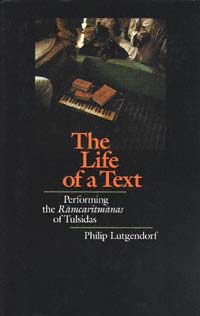 | Title: The life of a text: performing the Rāmcaritmānas of Tulsidas Author: Lutgendorf, Philip Published: University of California Press, 1991 Subjects: Religion | Hinduism | South Asia | Cultural Anthropology Publisher's Description: The Life of a Text offers a vivid portrait of one community's interaction with its favorite text - the epic Ramcaritmanas - and the way in which performances of the epic function as a flexible and evolving medium for cultural expression. Anthropologists, historians of religion, and readers interested in the culture of North India and the performance arts will find breadth of subject, careful scholarship, and engaging presentation in this unique and beautifully illustrated examination of Hindi culture.The most popular and influential text of Hindi-speaking North India, the epic Ramcaritmanas is a sixteenth century retelling of the Ramayana story by the poet Tulsidas. This masterpiece of pre-modern Hindi literature has always reached its largely illiterate audiences primarily through oral performance including ceremonial recitation, folksinging, oral exegesis, and theatrical representation. Drawing on fieldwork in Banaras, Lutgendorf breaks new ground by capturing the range of performance techniques in vivid detail and tracing the impact of the epic in its contemporary cultural context. [brief] Similar Items |
| 19. | 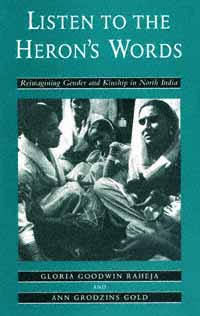 | Title: Listen to the heron's words: reimagining gender and kinship in North India Author: Raheja, Gloria Goodwin 1950- Published: University of California Press, 1994 Subjects: Anthropology | Cultural Anthropology | Folklore and Mythology | Women's Studies | South Asia Publisher's Description: In many South Asian oral traditions, herons are viewed as duplicitous and conniving. These traditions tend also to view women as fragmented identities, dangerously split between virtue and virtuosity, between loyalties to their own families and those of their husbands. In women's songs, however, symbolic herons speak, telling of alternative moral perspectives shaped by women. The heron's words - and women's expressive genres more generally - criticize pervasive North Indian ideologies of gender and kinship that place women in subordinate positions. By inviting readers to "listen to the heron's words," the authors convey this shift in moral perspective and suggest that these spoken truths are compelling and consequential for the women in North India.The songs and narratives bear witness to a provocative cultural dissonance embedded in women's speech. This book reveals the power of these critical commentaries and the fluid and permeable boundaries between spoken words and the lives of ordinary village women. [brief] Similar Items |
| 20. | 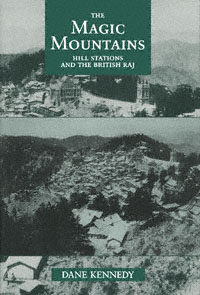 | Title: The magic mountains: hill stations and the British raj Author: Kennedy, Dane Keith Published: University of California Press, 1996 Subjects: History | Asian History | European History | South Asia Publisher's Description: Perched among peaks that loom over heat-shimmering plains, hill stations remain among the most curious monuments to the British colonial presence in India. In this engaging and meticulously researched study, Dane Kennedy explores the development and history of the hill stations of the raj. He shows that these cloud-enshrouded havens were sites of both refuge and surveillance for British expatriates: sanctuaries from the harsh climate as well as an alien culture; artificial environments where colonial rulers could nurture, educate, and reproduce themselves; commanding heights from which orders could be issued with an Olympian authority.Kennedy charts the symbolic and sociopolitical functions of the hill stations over the course of the nineteenth and early twentieth centuries, arguing that these highland communities became much more significant to the British colonial government than mere places for rest and play. Particularly after the revolt of 1857, they became headquarters for colonial political and military authorities. In addition, the hill stations provided employment to countless Indians who worked as porters, merchants, government clerks, domestics, and carpenters.The isolation of British authorities at the hill stations reflected the paradoxical character of the British raj itself, Kennedy argues. While attempting to control its subjects, it remained aloof from Indian society. Ironically, as more Indians were drawn to these mountain areas for work, and later for vacation, the carefully guarded boundaries between the British and their subjects eroded. Kennedy argues that after the turn of the century, the hill stations were increasingly incorporated into the landscape of Indian social and cultural life. [brief] Similar Items |